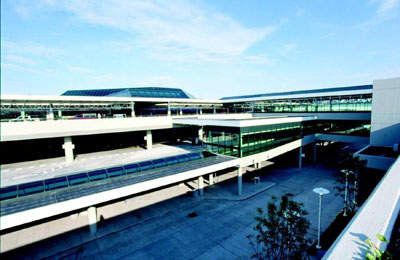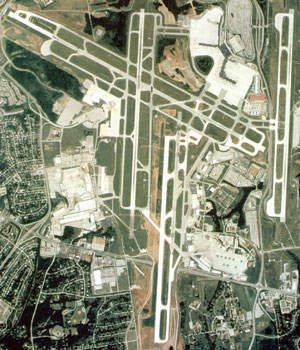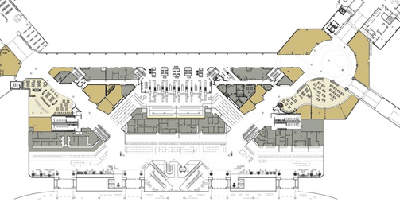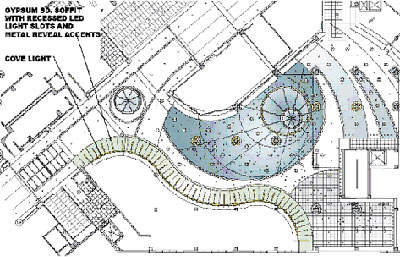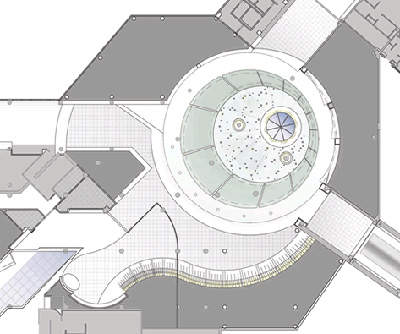Nashville International Airport is situated five miles southeast of Nashville and serves the southeastern regions of Tennessee. The airport receives on average 424 flights a day with 16 different airlines operating from the facility. The airport handled 9.4 million passengers and recorded 174,598 aircraft operations in FY 2011.
The airport has four concourses, A to D, and four runways, three asphalt and one paved with concrete, varying in length from just less than 8,000ft to more than 11,000ft.
The terminal complex has a 900,000ft² passenger terminal with 61 air carrier gates. The airport has 78 commuter parking slots.
In 2005 the Metropolitan Nashville Airport Authority (MNAA) decided the airport required a facelift and a degree of remedial work to keep it up to the standards expected by passengers, following 19 years of use since the last update.
The terminal renovation was scheduled into two phases to be completed over a period of five years.
Architectural Alliance and Thomas and Miller and Partners, who formed a joint venture, were the design architects for the project. The first phase of the renovation works started in October 2006 and were completed in January 2009 with an estimated cost of $46m. The $34.5m second phase of the project began in August 2009 and was completed in July 2011.
Renovation work on Nashville International Aiprort
In September 2006, the Metropolitan Nashville Airport Authority Board of Commissioners awarded the construction contract for the Nashville International Airport terminal renovation project to Brentwood-based Bell Construction Company for the first phase. The company’s bid came in just under $37m.
The renovation included construction of a consolidated security checkpoint composed of 12 lanes centrally located on the third floor, flanked by decorative water walls.
It also included 30 local and national brand-named food / beverage and news / gift concessions, a new HVAC system to improve temperature control, updated comfortable waiting areas, the installation of two 12ft flight monitors on the north and south ends of the terminal ticketing lobby and new windows in the terminal.
On 19 December 2008, Nashville International Airport opened a new exit with an expanded area in front of concourse C. The area provides easy access to ground transportation and to the baggage claim on the first floor level. The phase 2 construction work was awarded to Nashville-based Hardaway Construction Corp for a contract value of $17.85m.
The construction service was also provided by the small, minority and women-owned business enterprise (SMWBE) partners, which represent 12.9% of the contract value. The companies involved in the construction services were Hermosa, Boulton Enterprises, Sunago Builders, TG, Gipson Mechanical, TN Coatings, Modular Designs of Memphis and Jarvis Signs.
Phase two involved the renovation of all existing restrooms and construction of larger restrooms on the ground transportation level. The phase was a major project involving renovation of terminal and concourse carpeting and tiles, along with interior terminal repairs. The project included renovation of airline gate hold rooms, replacement of HVAC units, enlargement of the ticket lobby and replacement of all wall coverings with new and recycled contents.
The airport was also installed with automatic sensors, hand dryers in the rest rooms and a new in-line explosive detection system (EDS) for improving the security of the baggage screening process.
The second phase also included additional renovations such as replacement of all elevators, exterior terminal repairs, additional security cameras and the relocation of ticket counters. In February 2010, the airport began construction on a 1.2 million ft2 rental car facility in the Long Term A parking lot. The facility is expected to be completed by November 2011.
In July 2011, the terminal was named after Robert C. H. ‘Bob’ Mathews Jr , who served as Chairman of MNAA’s board for more than 22 years.
Runway reconstruction for the American airport
In August 2009, the oldest runway, 2L-20R, was closed and reconstruction was started with the aim of enhancing aircraft safety. The $24m project was awarded to Harper Company, along with 7.78% of the contact value to disadvantaged business enterprise (DBE) partners. The refurbished runway was re-opened in August 2010. It features new grooved concrete surfaces and improved 35ft wide asphalt shoulders.
Subcontractors for DBE include Jen-Hill Construction Materials, Geotek Engineering, Lane Hauling and Excavating, Michael Harris Construction Company, Brighter Days and Nites, Randolph Trucking, Kathy Freeman Trucking and Southern Erosion Control.
Concessions
Travel retailer Hudson Group and its partners were selected to upgrade the news / gift and specialty retail concession programme at Nashville International Airport as part of the terminal renovation project. The available spaces were grouped into two separate packages.
Following a competitive bidding process, the MNAA awarded both packages (all the available retail space) to Hudson and its partners J&B Enterprises, CBR Inc and Olympic Supply Inc.
The retail contract will run for ten years until 2017 and the Hudson Group will provide a targeted mix of newsstands, bookstores and specialty retail concepts specifically designed to meet the airport’s requirements while capturing the distinctive sounds, flavours and spirit of Nashville.
The airport also restructured the restaurant services it provides by removing its central facility and introducing 23 smaller restaurant concessions mostly from the local area, which provide a range of food choices from burgers to Chinese, Mexican, Italian or just coffee.
Taxiway upgrades
In August 2006, the MNAA received a $1.3m federal grant from the US Department of Transportation (DOT) to aid in financing rehabilitation for taxiway T-2 at Nashville. DOT awarded the grant in support of the project, facilitating construction of the taxiway upgrade, which consists of a full depth reconstruction and new asphalt.
Located at the north end of runway 2L-20R, taxiway T-2 provides direct access to concourses A and B. The taxiway rehabilitation allowed the airport to continue its unrivalled safety record. This was just a small part of an $11m airfield improvement programme instigated in 2006, using funds obtained from DOT and the FAA.
MNAA has also designed a terminal access roadway improvement (TARI) project to improve traffic on the one-way road that surrounds parking facilities around the terminal. The first phase of the TARI project started in October 2008 and was completed in October 2009.

